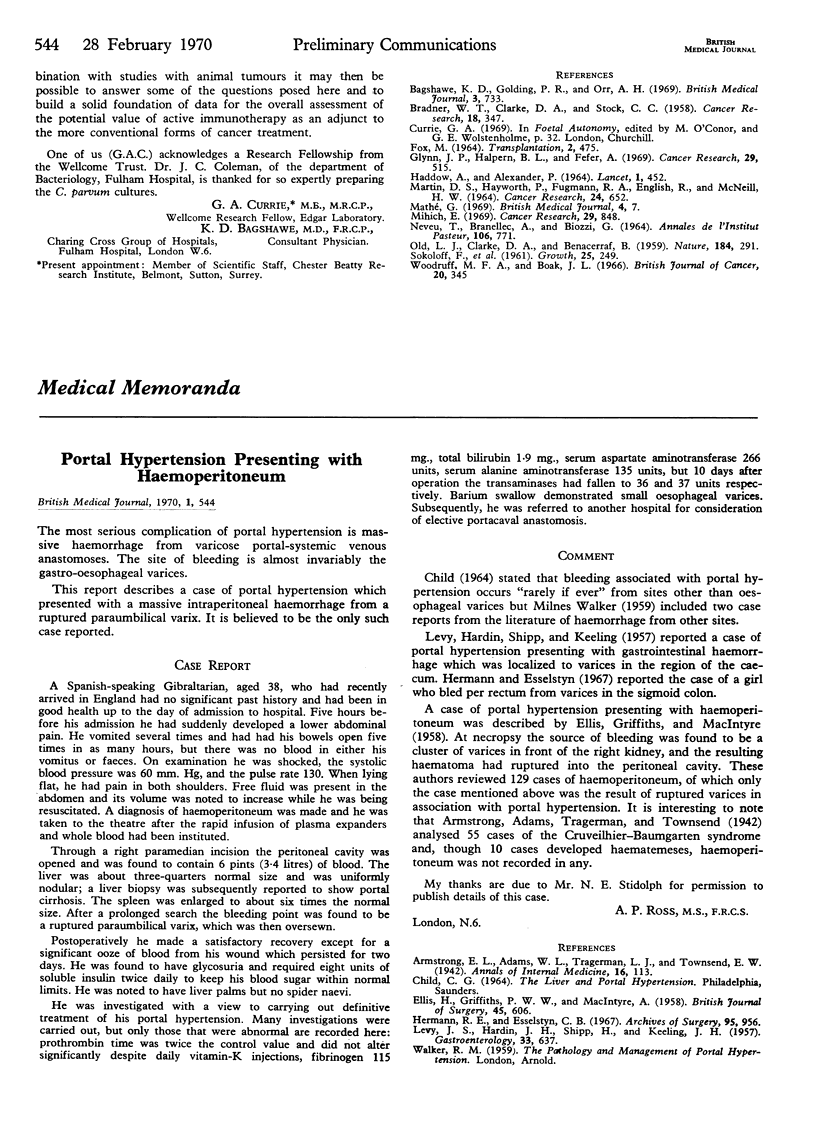Abstract
Corynebacterium parvum used alone to enhance immunological reactivity produced transient inhibition of the growth of chemically induced isogenic mouse tumours. Attempts were made to combine C. Parvum with cyclophosphamide to see whether this would increase the latter's effectiveness in inhibiting early but established tumours. Of the various regimens tested, the administration of the C. parvum 12 days after a single dose of chemotherapy produced dramatic inhibition of tumour growth and resulted in complete and lasting regressions in up to 70% of tumour-bearing animals. The most important variable in this regimen is the time between the chemotherapy and the subsequent immunotherapy.
It is possible that non-specific active immunotherapy with agents such as C. parvum may be a valuable adjunct to the conventional cyto-reductive treatments of cancer, but the time of administration of such therapy is probably critical for each tumour and for each chemotherapeutic regimen.
Full text
PDF



Selected References
These references are in PubMed. This may not be the complete list of references from this article.
- BRADNER W. T., CLARKE D. A., STOCK C. C. Stimulation of host defense against experimental cancer. I. Zymosan and sarcoma 180 in mice. Cancer Res. 1958 Apr;18(3):347–351. [PubMed] [Google Scholar]
- Bagshawe K. D., Golding P. R., Orr A. H. Choriocarcinoma after hydatidiform mole. Studies related to effectiveness of follow-up practice after hydatidiform mole. Br Med J. 1969 Sep 27;3(5673):733–737. doi: 10.1136/bmj.3.5673.733. [DOI] [PMC free article] [PubMed] [Google Scholar]
- FOX M. SUPPRESSION OF TISSUE IMMUNITY BY CYCLOPHOSPHAMIDE. Transplantation. 1964 Jul;2:475–486. doi: 10.1097/00007890-196407000-00004. [DOI] [PubMed] [Google Scholar]
- Glynn J. P., Halpern B. L., Fefer A. An immunochemotherapeutic system for the treatment of a transplanted Moloney virus-induced lymphoma in mice. Cancer Res. 1969 Mar;29(3):515–520. [PubMed] [Google Scholar]
- HADDOW A., ALEXANDER P. AN IMMUNOLOGICAL METHOD OF INCREASING THE SENSITIVITY OF PRIMARY SARCOMAS TO LOCAL IRRADIATION WITH X RAYS. Lancet. 1964 Feb 29;1(7331):452–457. doi: 10.1016/s0140-6736(64)90793-7. [DOI] [PubMed] [Google Scholar]
- MARTIN D. S., HAYWORTH P., FUGMANN R. A., ENGLISH R., MCNEILL H. W. COMBINATION THERAPY WITH CYCLOPHOSPHAMIDE AND ZYMOSAN ON A SPONTANEOUS MAMMARY CANCER IN MICE. Cancer Res. 1964 May;24:652–654. [PubMed] [Google Scholar]
- Mihich E. Combined effects of chemotherapy and immunity against leukemia L1210 in DBA-2 mice. Cancer Res. 1969 Apr;29(4):848–854. [PubMed] [Google Scholar]
- NEVEU T., BRANELLEC A., BIOZZI G. PROPRI'ET'ES ADJUVANTES DE CORYNEBACTERIUM PARVUM SUR LA PRODUCTION D'ANTICORPS ET SUR L'INDUCTION DE L'HYPERSENSIBILIT'E RETARD'EE ENVERS LES PROT'EINES CONJUGU'EES. Ann Inst Pasteur (Paris) 1964 May;106:771–777. [PubMed] [Google Scholar]
- OLD L. J., CLARKE D. A., BENACERRAF B. Effect of Bacillus Calmette-Guerin infection on transplanted tumours in the mouse. Nature. 1959 Jul 25;184(Suppl 5):291–292. doi: 10.1038/184291a0. [DOI] [PubMed] [Google Scholar]
- SOKOLOFF B., TODA Y., FUJISAWA M., ENOMOTO K., SAELHOF C. C., BIRD L., MILLER C. Experimental studies on Mitomycin C. 4. Zymosan and the R. E. S. Growth. 1961 Sep;25:249–263. [PubMed] [Google Scholar]
- Woodruff M. F., Boak J. L. Inhibitory effect of injection of Corynebacterium parvum on the growth of tumour transplants in isogenic hosts. Br J Cancer. 1966 Jun;20(2):345–355. doi: 10.1038/bjc.1966.42. [DOI] [PMC free article] [PubMed] [Google Scholar]


